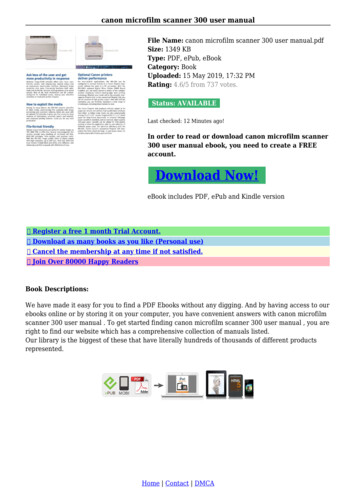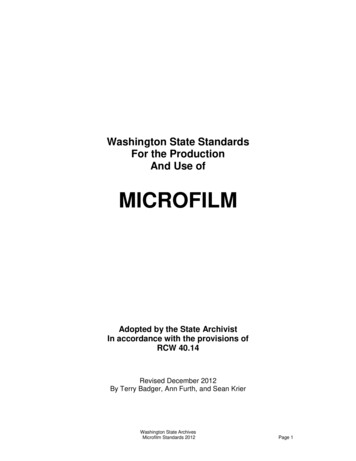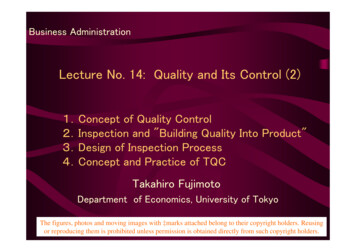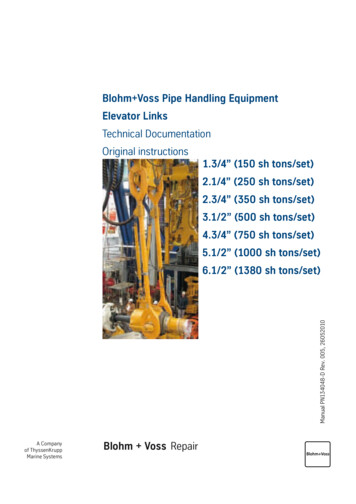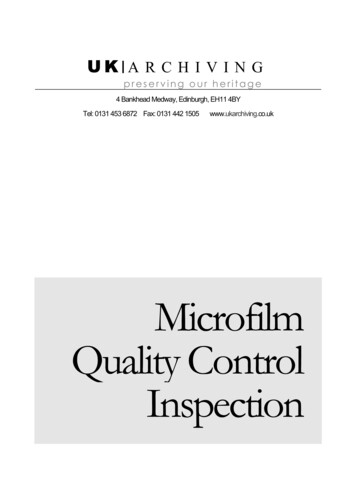
Transcription
UK A R C H I V I N Gpreserving our heritage4 Bankhead Medway, Edinburgh, EH11 4BYTel: 0131 453 6872 Fax: 0131 442 1505www.ukarchiving.co.ukMicrofilmQuality ControlInspection
This guide has been written to assist staff in the quality control inspection of microfilm. It is not a definitivedocument and as such is subject to change/review/revision from time to time. All information supplied is forreference and should you require more information please use the NPO guide, RLG poster, British Standardsand the supervisor for your area to assist you when difficulties arise.If you feel that there should be information added to this guide, please put your suggestion forward and theywill be discussed with all staff, if of relevance they will be included in the next draft.This guide for your reference, please use it. UK Archiving4Bankhead Medway, Edinburgh, EH11 4BYPhone 0131 453 6872 Fax 0131 442 1505Draft 3: 11th December 2006
Chapter 1IntroductionQuality Control Outcomes1.Inspect completed microfilms to determine compliance with standards.2.Make a technical check of completed microforms to determine correct processing, resolution, density and film base.3.Make a visual check of completed microforms to determine completeness, image legibility and compliance withspecifications required.4.Recording of quality control inspection details.General InformationCheck of the final product is especially important in preservation microfilming – where the aim is to preserve knowledge andcultural heritage for the benefit of future generations. Any errors or omissions will limit the usefulness and authenticity of themicrofilm. If the original material has deteriorated badly, it may be impossible to copy it again in the future.Apart from the preservation issues, quality control makes sense from an economic point of view, in checking that there is‘value for money’. After investing all the time, knowledge, skills and work in preparing, filming, processing and duplicationmicrofilm, it makes sense to check that the final product meets the required standards.In essence, a quality inspection program is the test of an organisation’s commitment to preservation microfilming. So, whetherthe microforms are produced by a separate microfilming organisation, or in-house, a regular quality control inspectionprogram should be established. Inspection should be carried out in a logical, structured manner, with specific levels andcriteria established before starting the inspection process.Work Area and EquipmentIt is useful to have a separate area set aside for quality checking. Enough space is needed around the area for staff to look atthe microfilms as well as the original documents (if required). Appropriate equipment for quality checking includes.1.Clean white cotton gloves2.Pair of film rewinds mounted on a level working surface3.Light box placed or built-in between the rewinds (or in densitometer)4.Eye loupe5.Microscope6.Densitometer7.Microfilm Reader8.Microfiche Reader (if required)1
Technical Inspection of Microfilm:CriteriaUse a densitometer to check that film density is within specificationsCheck the resolution test chart to confirm that the specified level of resolution has been achieved (please be advisedthat resolution is subjective to eyesight and can vary from person to person, if you are unsure that the resolution ofthe master film has been achieved ask another member of staff to check the resolution, without telling them whatyour findings are)Microfilm is visually checked for any defects which will cause the film to fail the Quality check2
Chapter 2Density InspectionDensityThe type of film, the exposure levels and how the film is processed influences density.Many preservation-microfilming projects specify minimum density ranges according to the contrast and types of material.Level of contrastDensity tests measure the level of contrast achieved between the dark and light areas on the film.On negative films the background density or maximum density (Dmax) is the dark part of the image and the minimumdensity (Dmin) is the clear part.Positive film is measure for Dmin only.The NPO Guide to Microfilming specifies that the following readings should be taken on every roll of film.GenerationMaximum (Dmax) DensityMinimum (Dmin) DensityMaster NegativeYesYesWorking NegativeYesYesWorking PositiveNoYesTaking a Density ReadingTaking a density reading from a master negative involves the following steps:StepComments1. Use a densitometer (calibrated)Use a densitometer which has been properly calibratedusing the calibration strip supplied with the densitometer2. Identify points for background density readingsSelect the background density readings (Dmax) from apart of the page without text or illustrations (this isusually the dark part of the image area)Avoid taking readings from inner or outer margins aspages may be discoloured around the edges (this may beunavoidable in some films)3. Take at least 8 density readingsTake a minimum of 8 Dmax readings throughout the rollof film, record your results on the QC sheetEnsuring a density range of no more than 0.20 acrosseach roll of film.(E.g. Min Density 1.10 - Max Density 1.30)4. Average the readingsAdd all the readings together and divide by 8 to give youthe average reading throughout the film, record result onQC sheet3
5. Take 1 Dmin readingSelect the clear area between frames to obtain the Dminreading, record your result on the QC sheetThis reading is also known as base fog readingDensity LevelsThe NPO guide specifies certain background density levels for different types of materials. These are shown in thetable below:ClassificationDescription of DocumentsGroup 1High quality, high contrast printed books, periodicalsand black typing (usually current material)(UK Archiving Aim Standard)Group 2Group 3Group 4Group 5Background DensityFine-line originals, black opaque pencil writing, anddocuments with small, high contrast printing (thiswill include current newspapers)(UK archiving Aim Standard)Pencil and ink drawings, faded printing and verysmall printing such as footnotes at the bottom of aprinted page (this will include older newspapers,although in some case you will have to use group 2)(UK Archiving Aim Standard)1.30 – 1.50(1.20 – 1.40)1.15 – 1.40(1.10 – 1.30)1.0 – 1.20(1.0 – 1.20)Low Contrast manuscripts and illustrations, graphpaper with feint lines; letters typed with worn ribbon;poorly printed, pale or coloured documents(UK Archiving Aim Standard)(0.80 – 1.10)Poor contrast documents(UK Archiving Aim Standard)0.70 – 0.85(0.70 – 0.90)0.80 – 1.10These levels are only a guideWe aim to achieve the center point in these levels and try to avoid a variance of less/more than the .10 above andbelow (allowing for the 0.20 variance on a given page of material). Please be aware that in certain circumstances thefilm may fall out with these levels and a reason for the variance given.In practice, the recommended density level is a guide only. Many originals are far from ideal, with poor contrast, finelines, mixture of text types, mixture of background colours and print quality. Simply specifying a high backgrounddensity may produce an image, which may not be legible. This is one reason why preservation microfilming has beendescribed as an art, as well as a science.Other problems, which materials have, are, a number of contrast levels on one page (e.g. text and photographs) andthese may require multiple exposure at different settings.Before filming a step test should have been carried out to determine the best density that suits the material beingfilmed. It is best practice to check with the camera operator if there is a variation to the above table for a given reason.With time and knowledge it is possible for some operators to be able to determine in advance if material needs to fallout-with the classifications listed above, example:4
Case Study:Group 4: Manuscript – original material is only 25% readable due to very dark patches across the page, in someinstances it completely unreadable. This had been caused by various factors – dirt, poor conditions, water damage etc.Solution: The material was filmed at a higher density level – in this case 1.50 – 1.70, the master is visibly too dark toview properly on a microfilm reader, but the resultant positive produced gave a clear 95% readable image.This is what we are aiming for, to be able to reproduce material that would otherwise be deemed unfit for the use itwas intended.Uniform density targetThe uniform density target is another of the technical targets that are quality-checked. This target is used to check howwell the camera lamps are balanced. The target is nothing more than a white sheet of card or heavy paper. This targetis filmed twice at the same exposure level (not necessarily at the exposure level for the material) immediately beforethe start and end targets. Ideally the target should be the same size as the actual frame to give a more accuratemeasurement.It should be noted however with camera’s that have low level, cool lighting attached, that light balance is a matter offiltration and diffusion not the angle of the bulbs as with older light sources. It should be noted however that low levellighting comes with diffusers fitted and often a light reflector clipped to the middle of the lamps. In some instances thereflector has to be removed to achieve a balanced background density. This is purely dependent on the type of lightingsystem you use.After processing, the density readings of both uniform density targets are compared for any significant variation,which might indicate lighting, camera or processing problems.Feature of uniform density targetDetailsAreas to be testedAll four corners plus the centre (note you may find thatthe centre reading is slightly higher than the corners)Generation to be testedMaster NegativeLevelsDensity of all areas tested should lie between 0.90 – 1.50DifferencesDensity of all five areas area’s should not be more than0.10 in the density rangeArea to be testedWithin the circles drawn on the uniform density target5
Chapter 3Resolution InspectingResolutionResolution is the degree to which fine details can be distinguished. The higher the resolution, the finer the detailreproduced. The resolution test chart appears in the start sequence.The resolution targets are five individual charts. One is in the centre of the frame; the other four are placed in thecorners so that they correspond to the corners of the largest documents being filmed. Each pattern on the resolutionchart has a rating.SampleIt should be noted that there are several different types of resolution chart available, the standards states that 5individual charts be used to ensure a more accurate placement of the targets. The resolution chart used is: PM-13½”x4” Photographic Microcopy Target, NBS 1010a ANSI/ISO #2 equivalent.Calculating ResolutionThe test patterns on ISO resolution chart #2 should be examined with a microscope, to determine the smallest patternthat can be resolved, i.e. the smallest in which all five individual lines in the pattern can be clearly distinguished inboth directions. All five test charts must be read noting the smallest pattern which can be read for each. Resolution isthe worst reading which is obtained from the five results – commonly in the corner patches. (source: “NPO Guide toPreservation Microfilming” “BS ISO 3334:2006 Micrographics ISO resolution test chart No.2 Description and Use”)StepsComments and Examples1. Inspect under a microscopeInspect the filmed image of the resolution chart under amicroscopeHandle film carefully with cotton glovesLift and move the film do not push across microscopeplain as this will scratch the image2. Examine pairs of line patterns and move from larger tosmallerEnsure that both horizontal and vertical lines can beclearly distinguishedKeep on looking down the patterns to the smallest linepairs, it is possible to clearly distinguish(1.0 largest, 18 smallest)3. Select the smallest pair of line patterns that can beresolvedThe fine lines should be clearly distinguishable in bothdirections4. Record Line Pairs per Millimetre (LPM)Record your results on the QC sheet provided for the film6
5. Check all 5 chartsAll five charts must be checked in this manner todetermine which chart has the smallest pattern resolvable(this would be the worst one readable)6. Calculate the resolutionUsing a calculator to determine the resolution of the film.I.e. reduction ration x lpmExample:Smallest pattern resolves 6.3Reduction Ratio used 18xResolution outcome 6.3 x 18 113.4lpm7. Record resolutionRecord your results on the QC sheet provided for the filmGuide to British Standards for ResolutionThe following is the standard for LPM at a given reduction ratio:RRXLP LPM9x9.0 81 lpm10x9.0 90 lpm11x8.0 88 lpm12x8.0 96 lpm13x8.0 104 lpm14x7.1 99.4 lpm15x7.1 106.5 lpm16x7.1 (6.3) 113.6 lpm17x6.3 107.1 lpm18x6.3 113.4 lpm19x6.3 (5.6) 119.7 lpm20x5.6 112 lpm21x5.6 117.6 lpm22x5.6 123.2 lpm23x5.0 115 lpm24x5.0 (4.3) 120 lpm25x4.5 (4.0) 112.5 lpm7
Resolution LevelsIn preservation microfilming a minimum level of resolution is often specified. The following are levels that arecommonly achieved, but will vary from camera to camera and chart to chart.GenerationRecommended ResolutionMaster Negative100lpm minimumWorking NegativeShould not be more than one level lower than the mastergenerationWorking PositiveShould not be more than one level lower than theworking negative. It is common in most place that theworking positive is not tested as it is generally the accesscopy8
Chapter 4Visual InspectionUnless the microfilm is a complete, accurate and legible copy of the original material, it fails to meet preservationrequirements, even if its technical quality is excellent. If the microfilm meets all the technical standards, it should bevisually checked for defects. This involves placing the film on a reader and inspecting it, frame-by-frame. This shouldbe compared with the original material (if available).How many and how much should be checked?Experience suggests that the only reliable method of confirming that the microfilm is a complete and accurate recordis to carry out a frame-by-frame inspection of the Master Negative. As many organisations do not have the resourcesto do frame-by-frame checking, the question of how many should be checked becomes an individual risk managementissue. It is our opinion that every film should be checked to guarantee the preservation microfilm.Checking for completeness and compliance to standardsThe film should be checked for completeness, legibility, physical condition and compliance with the standards. Itshould be a complete, accurate and legible copy of the original material.The following is a typical list of feature to check in a detailed visual inspection. Always refer to the RLG poster for afull list of defects if requiredCheck forCommentsCompletenessOriginal Material has been filmed in its entiretyThere are no missing pages/issuesInformation has not been lost due to gutter shadowTargets (see examples atend of manual)All of the Technical and bibliographic detail targets have been filmedAll of the targets appear correctly and in the correct orderAll of the targets are in the correct orientation for the filmAlignmentThe Image is aligned correctly within the frame, with no more than a 5 skew from theverticalOrientationImage orientation is according to specification e.g. single or double frame, Broadsheet orTabloidImage orientation is according to specification for digitisationReduction RatioThe reduction ratio used nearly fills the frame, with all the edges of the document visibleLegibilityAll of the information is easy to read (regardless of resolution and density levels)DensityThere are no major variations in densityPhotographs or other features are neither to light nor too darkMultiple exposure are used to film originals with variations in densityFocusThere are no blurred images – especially near splices (this is relevant to the duplicatecopy only)9
Foreign objectsThere are no additional objects in the images e.g. operators hands, tape, pencils etcFoggingThere is no fogging or extra light which may cloud the imageSplicingOnly the master has been splicedSplices have been made using an ultrasonic splicerAdjacent frames are not scratched or blurredThere are no more than 6 splices per filmThere are no splices between the technical target and the first ten frames of the materialbeing filmedDefective frames have been removed/replaced where necessaryAt least two pages before and after the page being refilmed are included in the retakeScratchingThe film is free from scratching (see RLG poster for what is acceptable andunacceptable)Marks/Abrasions(Physical condition)The film is free from blemishes, dust, fingerprints, water spots and other defectsQuality Check Inspection RecordAny quality problems that have been identified should be recorded systematically. Clear and accurate records ofproblems will help in the next stage of deciding on the actions to take. Most organisations create their own qualityinspection record sheets.We use a job record envelope, which follows the film through the entire process from preparation to duplication. Allinformation should be recorded fully on the envelope to give the camera operator a clear set of instruction to rectifyany errors there may be.Problems: causes and actionsOnce problems have been identified, the next stage is identifying the causes. This will help in determining what to donext. The original text should always be checked in this process. For example, a stain on the original. No furtheraction can be taken in this case.In other cases where the cause is likely to be a problem with the equipment or the operator, further action needs to betaken to prevent the problem recurring.If any of the problems are found within the inspection list above, the film needs to be sent back to have the problemsrectified, spliced in and rechecked before in can be considered as being to preservation standards.10
Chapter 4SummaryUnless the microfilm is a complete, accurate and legible copy of the original material, it fails to meet thepreservation requirements, even if its technical quality is excellent.Check the resolution and density of every roll of film.Every roll of film produced should be checked in its entirety.All relevant information should be recorded to give a complete and accurate assessment of the film being checked.Any retakes are checked before duplication commencesYou are aware of all the standards and other relevant information required to carry out quality controlYou have all the equipment and associated materials to carry out quality controlCotton gloves must be worn when handling microfilmYou must handle microfilm gently and with care to avoid causing damaged11
Chapter 5Appendix1. Example of Quality Assurance Sheets2. Example of Start Sequence3. Example of Bibliographic Targets4. Example of Copyright Statement12
2Examples of Targets used In the Start SequenceAll the boards shown in this example form part of the Start Sequence. Along with these there are the standards ISO targetsthat are used. The following is a typical start sequence layout.StartFilmed byCopyrightTitle Board (bibliographic target)Best Copy AvailableReel ContentsAny other as needed targetsResolution TargetMaterialEnd BoardEnd of ReelPlease be aware that when filming of material that is owned under copyright by the client, they may supply their own startsequence. The sequence should be filmed in the order that they have specified.13
3DumfriesDumfries &GallowayStandard (Wed)14
3REEL CONTENTS2342thStart Date: January 4 2005thEND DATE: June 29 2005FILMED:REDUCTION:FILM SIZE:35 mmFRAME COUNT:FILMER:PRESSMARK: 20415
3END OF REELPLEASEREWINDDumfries & Galloway Standard (Wed)Dumfries16
4COPYRIGHT STATEMENTThis film has been supplied by UK Archiving Ltd a divisionof SNMU Ltd, 4 Bankhead Medway, Edinburgh EH11 4BY,on the condition that neither it nor any part of it is furtherreproduced, copied, digitized, processed or made availablein any form or media without the express written permissionof the SNMU Ltd.Please note that the material filmed has itself copyright andsimilar rights, and therefore the permission of the owners ofthat copyright will also be required for such reproduction.Under certain conditions specified by law, libraries andarchives are authorized to furnish private users with aphotocopy or other reproduction, on the condition that thephotocopy or reproduction is not to be “used for anypurpose other than private study, scholarship, or researchfor non-commercial purposes”, Only limited copies areavailable under these provisions and no other uses arepermitted without written permission.Any use of this film without these permissions and/or inexcess of the “Fair use provisions” may result inprosecution for copyright infringement and/or a claim fordamages.17
MICROFILMED BYUK ARCHIVING LTD4 BANKHEAD MEDWAYEDINBURGHEH11 4BY0131 453 6872www.ukarchiving.co.uk18
microfilm, it makes sense to check that the final product meets the required standards. In essence, a quality inspection program is the test of an organisation's commitment to preservation microfilming. So, whether the microforms are produced by a separate microfilming organisation, or in-house, a regular quality control inspection
